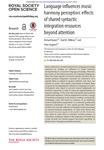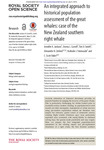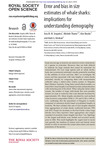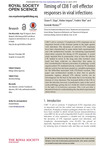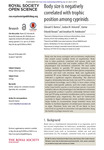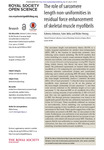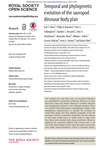Education: Recent submissions
Now showing items 81-100 of 806
-
The relationships of the Euparkeriidae and the rise of Archosauria
(2016)For the first time, a phylogenetic analysis including all putative euparkeriid taxa is conducted, using a large data matrix analysed with maximum parsimony and Bayesian analysis. Using parsimony, the putative euparkeriidDorosuchus ... -
Feet, heat and scallops
(2016)The effects of unnatural disturbances on the behaviour and energetics of animals are an important issue for conservation and commercial animal production. Biologging enables estimation of the energy costs of these disturbances, ... -
Predicting plant attractiveness to pollinators with passive crowdsourcing
(2016)Global concern regarding pollinator decline has intensified interest in enhancing pollinator resources in managed landscapes. These efforts frequently emphasize restoration or planting of flowering plants to provide pollen ... -
Language influences music harmony perception
(2016)Many studies have revealed shared music–language processing resources by finding an influence of music harmony manipulations on concurrent language processing. However, the nature of the shared resources has remained ... -
Hybridization generates a hopeful monster
(2016)Compared with other phylogenetic groups, self-fertilization (selfing) is exceedingly rare in vertebrates and is known to occur only in one small clade of fishes. Here we report observing one F1-hybrid individual that ... -
An integrated approach to historical population assessment of the great whales
(2016)Accurate estimation of historical abundance provides an essential baseline for judging the recovery of the great whales. This is particularly challenging for whales hunted prior to twentieth century modern whaling, as ... -
Assessing recognition memory using confidence ratings and response times
(2016)Classification of stimuli into categories (such as ‘old’ and ‘new’ in tests of recognition memory or ‘present’ versus ‘absent’ in signal detection tasks) requires the mapping of internal signals to discrete responses. ... -
Error and bias in size estimates of whale sharks: implications for understanding demography
(2016)Body size and age at maturity are indicative of the vulnerability of a species to extinction. However, they are both difficult to estimate for large animals that cannot be restrained for measurement. For very large species ... -
Timing of CD8 T cell effector responses in viral infections
(2016)CD8 T cell or cytotoxic T lymphocyte (CTL) responses are an important branch of the immune system in the fight against viral infections. The dynamics of anti-viral CTL responses have been characterized in some detail, both ... -
Aremigratory behaviours of bats socially transmitted?
(2016)To migrate, animals rely on endogenous, genetically inherited programmes, or socially transmitted information about routes and behaviours, or a combination of the two. In long-lived animals with extended parental care, as ... -
A synthetic, catalytic and theoretical investigation of an unsymmetrical SCN pincer palladacycle
(2016)The SCN ligand 2-{3-[(methylsulfanyl)methyl]phenyl}pyridine, 1, has been synthesized starting from an initial Suzuki–Miyaura (SM) coupling between 3-((hydroxymethyl)phenyl)boronic acid and 2-bromopyridine. The C–H activation ... -
Body size is negatively correlatedwith trophic position among cyprinids
(2016)Body size has many ecological and evolutionary implications that extend across multiple levels of organization. Body size is often positively correlated with species traits such as metabolism, prey size and trophic position ... -
Segregated water observed in a putative fish embryo cryopreservative
(2016)Development of new cryopreservation strategies has major potential in medicine and agriculture and is critical to the conservation of endangered species that currently cannot be preserved. A critical property of any potential ... -
The role of sarcomere length non-uniformities in residual force enhancement of skeletal musclemyofibrils
(2016)The sarcomere length non-uniformity theory (SLNT) is a widely accepted explanation for residual force enhancement (RFE). RFE is the increase in steady-state isometric force following active muscle stretching. The SLNT ... -
MiFish a set of universal PCR primers for metabarcoding environmental DNA from fishes
(2015)We developed a set of universal PCR primers (MiFish-U/E) for metabarcoding environmental DNA (eDNA) from fishes. Primers were designed using aligned whole mitochondrial genome (mitogenome) sequences from 880 species, ... -
Adaptive collective foraging in groups with conflicting nutritional needs
(2016)Collective foraging, based on positive feedback and quorum responses, is believed to improve the foraging efficiency of animals. Nutritional models suggest that social information transfer increases the ability of foragers ... -
Social familiarity affects Dianamonkey alarm call responses in habitat-specific ways
(2016)Male Diana monkeys produce loud and acoustically distinct alarm calls to leopards and eagles that propagate over long distances, much beyond the immediate group. Calling is often contagious, with neighbouring males responding ... -
Short and long term consequences of developmental saline stress
(2016)Secondary salinization has been identified as a major stressor to amphibians. Exposure to elevated salinity necessitates physiological adjustments and biochemical changes that may be energetically demanding. As such, ... -
Comparative phylogenetic analyses uncover the ancient roots of Indo-European folktales
(2016)Ancient population expansions and dispersals often leave enduring signatures in the cultural traditions of their descendants, as well as in their genes and languages. The international folktale record has long been regarded ... -
Temporal and phylogenetic evolution of the sauropod dinosaur body plan
(2016)The colossal size and body plan of sauropod dinosaurs are unparalleled in terrestrial vertebrates. However, to date, there have been only limited attempts to examine temporal and phylogenetic patterns in the sauropod ...




